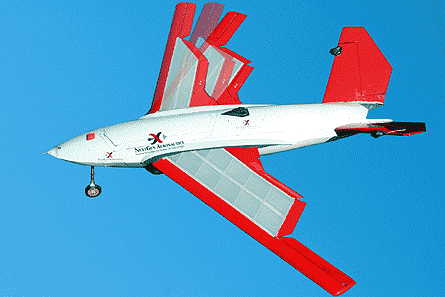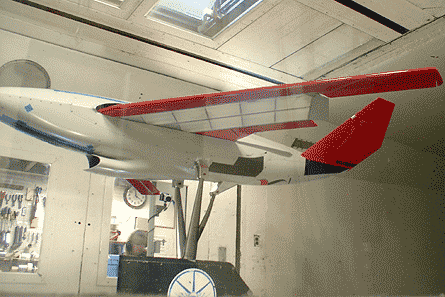Washington, DC
Lockheed and NextGen to demonstrate aggressive flight manoeuvres in next phase
Following successful in-flight tests of a shape-changing wing, two teams have been funded to demonstrate aggressive manoeuvring using fast morphing. Unmanned air vehicles built by Lockheed Martin and NextGen Aeronautics will use rapid changes in wing shape to perform steep climbs and tight turns following an attack on a target.
NextGen, with funding from Boeing Phantom Works, demonstrated its flexible-skin morphing wing in flight on 1 August, using a subscale remotely piloted vehicle called the MFX-1. Changes in area of 40% and span of 30%, with sweep varying from 15° to 35°, were achieved in flight at speeds of around 100kt (185km/h).
Torrance, California-based NextGen says the flights, at the Camp Roberts test range in California, were the first of a wing whose area, chord, sweep and aspect ratio can be changed in flight. Lockheed's Skunk Works abandoned efforts to fly its folding-wing morphing design after the subscale autonomous vehicle crashed twice during take-off attempts because of flight-control software issues.
|
|---|
| NextGen says area, chord, sweep and aspect ratio of its flexible-skin morphing wing (above) can be changed in flight. Fast morphing (below) is the next phase. |
 |
The tests rounded out Phase 2 of the US Defense Advanced Research Projects Agency's (DARPA) morphing aircraft structures programme. This is demonstrating technology for an unmanned "hunter-killer" combining the loiter endurance of a surveillance platform with the high-speed dash of an attack aircraft in a single shape-changing vehicle.
Phase 2 included successful windtunnel tests of large-scale half models of the competing morphing wing designs (Flight International, 6-12 June).
A revised third phase is taking a slightly different tack, with DARPA funding Lockheed and NextGen to demonstrate the advantages of fast symmetric and asymmetric wing morphing for specific flight manoeuvres. One is a rapid pop-up to gain altitude after a high-speed attack. The other is a limited-radius turn after the attack to inspect or re-attack the target.
"The challenge is morphing quickly, and having the flight-control system keep up," says Dr Terry Weisshaar, DARPA programme manager. The test will involve 90kg (200lb)-class turbojet-powered unmanned air vehicles capable of rapid morphing between two wing shapes. NextGen's flight tests have been scheduled for January, at Camp Roberts, and Lockheed's for February, at the company's Helendale facility in California.
Boeing Phantom Works has joined NextGen as a subcontractor on its MFX-2 UAV, a larger twinjet version of the MFX-1 with improved flexible-skin wing design. Windtunnel tests start in November. Lockheed's design is based on its unsuccessful "Yellow Bird" folding-wing UAV, with a larger engine and new flight-control system supplied by Athena Technologies.
The small UAVs will use battery power to morph between two wing shapes "a couple of times" on each 30min flight, says Weisshaar. Controlling an aircraft that morphs during manoeuvres is challenging because conventional flight-control laws assume the vehicle's shape is constant. "Vehicle state now includes geometry. Flight control is highly non-linear and rapidly time-variant," he says. "We have to prove we can control the aircraft during rapid manoeuvres."
Source: Flight International
























